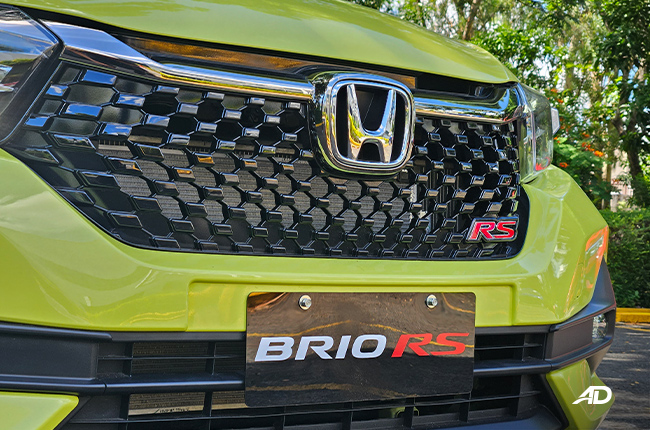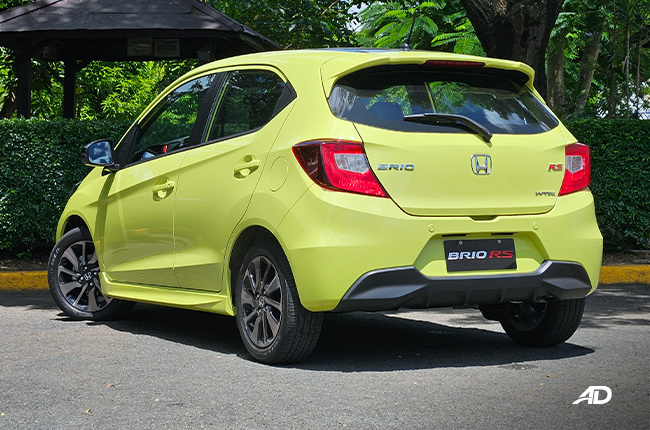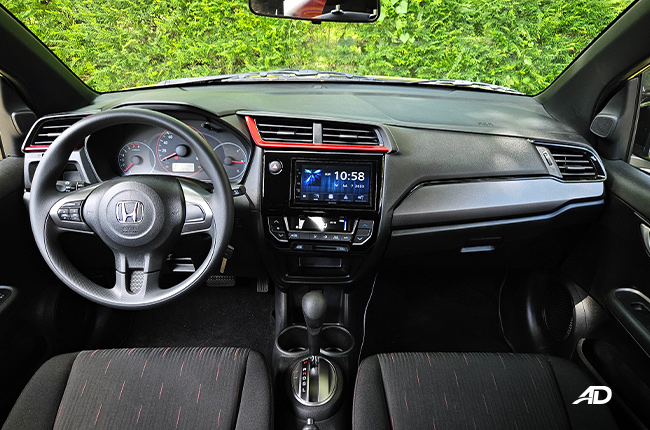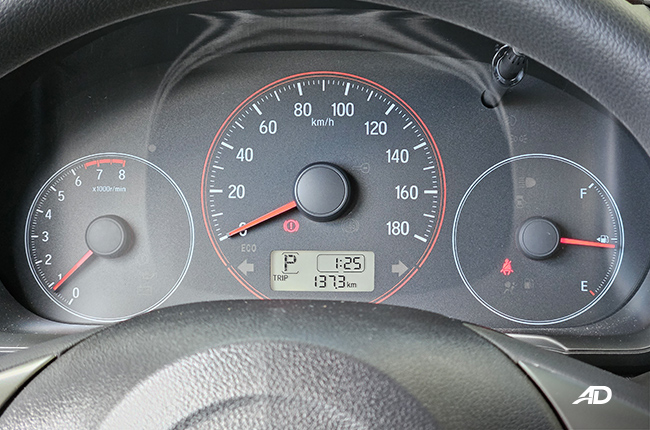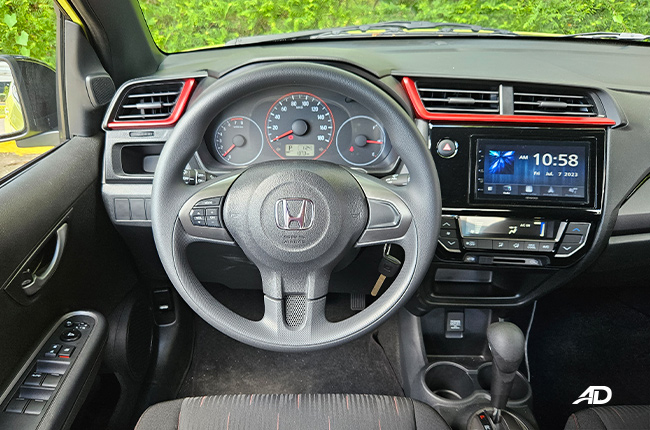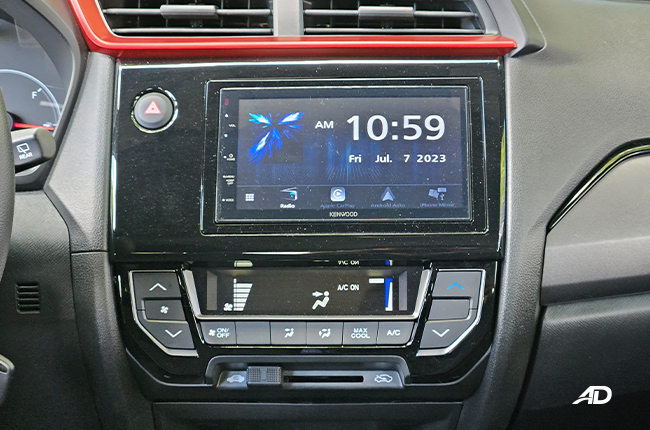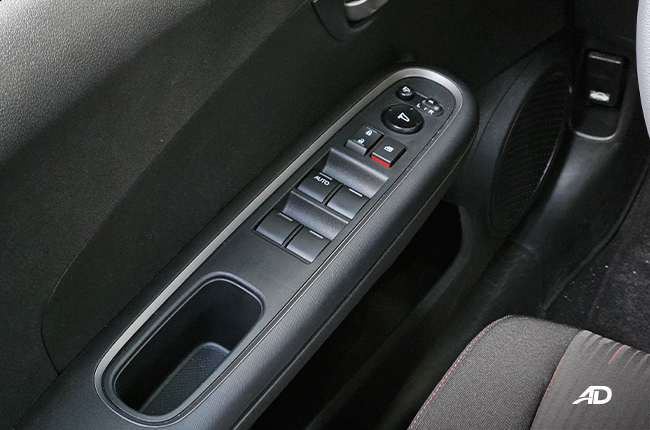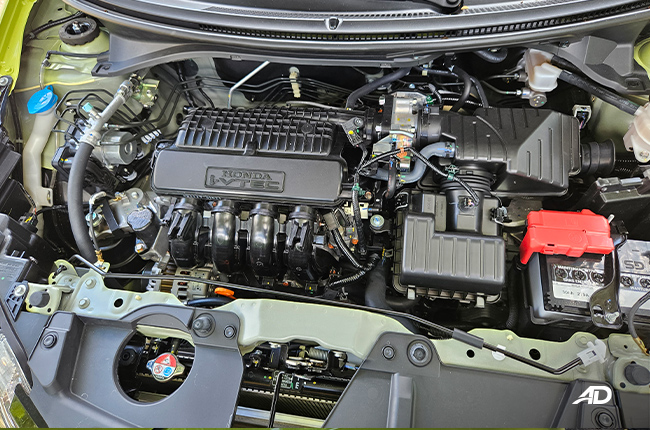
Honda had a twin launch for the Honda Brio and the Honda City, and both models were able to catch a lot of attention from long-time Honda fans, and new buyers alike. The Brio is the small hatchback in the Honda lineup, and after quite some time on the market without any major update, it was about time that Big H debuted its mid-cycle refresh.
We’re happy to report that most of our wishlist items for an update were fulfilled, and we’re sure that even after just a short drive around, this is the same great-driving hatchback that many have come to love in the past, but better and more modern than before, let’s explain.
Exterior
The Honda Brio RS was one of the coolest-looking small hatchbacks when it was launched, and Honda has extended its appeal for 2024. The new model gets a new set of front bumpers, trims, kits, lips, and skirts. The grille is the most striking change, however. We had the pleasure of being able to cover the V variant of the model, and the two have similar-looking grilles, though the RS simply looks better.
The Brio RS also features a new color, Electric Lime Metallic, and what a color indeed. While one of our favorite hues in the past was the Carnival Yellow, this is just as—if not a little more—striking and attention-grabbing. Paired wit the RS trimmings and the black-top roof, the Brio presents a very eye-catching look, especially with a Honda’s other exterior enhancements.
The most major update that we liked was the headlights and the foglamps, now finished with LEDs. The RS trim still gets most of the goodies from the pre-facelift, but the headlights really amp up the model’s premium-ness, and it’s also a bright set of bulbs, even noticeable in the daytime. Those looking to pick up the new Brio would be wise to consider the top-of-the-line RS trim, and you also get updated body kits to really set it apart from the pre-facelift model. Overall, a remarkable upgrade in terms of style and utility.
Interior
While the exterior had a few major enhancements, the interior changes weren’t as bold. Still, we’re getting colored trim, but unlike the pre-facelift, the new model comes with red accents in only two areas, there is no more RS logo in the gauge cluster, and the rest of the trim is finished in grey instead of an orange accent color. Lower variants of the Brio will get an all-grey and black-colored interior, but only the RS gets a little hit of red, equating to a bit of sportiness if you ask us. It would have been a nice touch if Honda decided to color-match the interior trims to the body color of the car, but given the red accents of the RS brand, it still kind of matches, unlike the metallic orange that once graced the interior of the pre-facelift RS variant of the Brio.
We’re also happy to report that the headliner of the RS is still clad in black, allowing the hatch to look very cohesive from a design standpoint, also, Honda made it a point to match the seats, with the upholstery now sporting red accents instead of orange, unlike before. We feel that Honda made the right choice by dialing some of the accents back and making the cabin a little more mature while retaining some of the sporty RS color blocking that quite a number of buyers have come to love over the years.
Other than that, we have a few more tech features to play with. A new Kenwood head unit comes in at seven inches, and it’s more capable than ever before. The USB port is located in the glove compartment, however, it allows users to plug in their smartphone and pair with the system for either Apple CarPlay or Android Auto. The system also allows users to further customize the sound profile and even the display colors of the head unit. During our short stint with the RS variant with up to six speakers, we can proudly say that Honda is still one of the brands to beat in terms capable audio quality, even at the most affordable price points. The Brio returns good bass for a two-way audio system, it returns good amounts of clarity in the mids and highs, and considering that this model is the entry-point in the lineup, is also just as impressive.
However, the other things that are okay, but not too hot with the Brio still persist. While we do get a pair of parking sensors at the rear, no reverse camera was fitted for the small hatch. While the Brio is still one of the roomiest small hatchbacks with regard to rear passenger accommodations, the are still lap belts for the middle passenger, and the rear bench doesn’t feature a split-fold function. The whole bench still comes down as one unit to make room for more cargo space, and if you want to nit pick, the steering wheel is still polyurethane, and most of the interior trimming is finished in plastic. However, all of these things were definitely not deal breakers for us, and overall, it was still a very enticing interior package presented, as far as first impressions go.
Driving first impressions
The Honda Brio drives like before, and we mean that as a compliment. We were able to drive around Honda Cars Philippines, Inc.’s testing grounds, and the Brio was as familiar as ever. The turning radius of the small hatch is still one of the tightest we’ve tried, even compared to the Honda City we drove side-by-side, and the steering wheel still returns a lot of feels even while going slow. While still not feather-light, the steering was nicely-weighted and added a bit of security to an otherwise small car. The chassis is still the same as before, so we expect the model to be relatively comfortable and handle great on twisty roads.
Powering the Brio is still the tried-and-tested 1.2-liter naturally-aspirated four-cylinder gasoline engine with i-VTEC that punches out 89 hp and 119 Nm of torque mated to a CVT in the RS and the V, and a five-speed manual transmission in the S trim. While not ground-breaking, we found the engine to be good for city drives, and just enough for stints on the highway. We’ll say the same as well for this facelift. Power figures are still the same, and the CVT is still the same, so nothing really changes from pre-facelift to facelift.
Overall, nothing really changes, and that’s a good thing. The Honda Brio is expected to be still as nimble, as peppy, and as fun to drive as before.
Initial Verdict

While not all of our wishlist items were fulfilled by Honda Philippines in this update, most of what we needed were addressed, and now with a more capable head unit, a little assurance brought on by the rear parking sensors, new interior trim, and a striking new exterior design, we’re happy to report that the Brio has now climbed the ranks a bit once again, and it’s set to take on the other rivals in its category like the all-new Wigo from Toyota.
Will it stack up? We think that this update is very timely, and we cannot wait to get it out on the road for a full review and pit it against one of its most bitter small hatchback rivals. Now, the model is definitely worth checking out, something that you should definitely do if you’re in the market.
Though, for the price of P863,000, as tested, it’s a little pricey, the same thing can be echoed for other affordable hatchbacks in the Philippines nowadays. As far as first impressions are going, however, the Brio is doing a good job at it, even with that over-P850,000 price tag.
Specifications
Engine
1.2 LFuel Type
GasolinePerformance
89 hp @ 6,000 rpmTransmission
CVT-
Summary
-
Name Honda Brio 1.2 RS Black Top CVT Body Type Hatchback Price ₱863,000 Transmission Category CVT -
Engine
-
Engine Size 1.2 L Displacement 1,199 cc Number of Cylinders 4 Number of Valves 16 Transmission Type Earth Dreams CVT -
Performance
-
Drivetrain Front-Wheel Drive Max Output (hp) 89 hp @ 6,000 rpm Max Torque (nm) 110 Nm @ 4,800 rpm -
Economy & Environment
-
Fuel Type Gasoline Emissions Standard Euro 4 Fuel Capacity 35.0 L *Combined Fuel Consumption 16.5 km/L *brand manufacturer claim
-
Dimensions
-
Length 3,811 mm Width 1,682 mm Height 1,487 mm Wheelbase 2,405 mm Turning Circle 9 m Ground Clearance 137 mm Trunk Capacity 258 L Number of Doors 5 Number of Seats 5 -
Safety & Security
-
Driver's Airbag 1 Front Passenger's Airbag 1 Side Airbag Curtain Airbag Knee Airbag Auto Brake System Electronic Brake Distribution Anti-lock Brake System (ABS) With Electronic Brake Force Distribution
Immobilizer Security Alarm Stability Control Electronic Door Locks Speed Sensing Door Locks ISOFIX Lane Departure Warning System Blind-Spot Detection System -
Features
-
Cruise Control Front Parking Sensors Rear Parking Sensors Leather Upholstery Push Start Button Wheel Size 15 in Wheels Metal Type Alloy Airconditioning System Manual with Digital Display Entertainment System 7-inch Capacitive Touchscreen Connectivity Apple CarPlay, Android Auto, Bluetooth, USB Port, AM/FM, Android Smartphone Mirroring Navigation Ready Warranty 3 Years (100,000 km) Keyless Entry Roof Rack Sunroof Electric Adjustable Seats Power Steering Power Windows Power Outlet Steering Wheel Audio Control -
Technology
-
Active Park Assist Hill Start Assist AWD Modes n/a Tire Pressure Monitoring Heads-up Display Power Liftgate Start-stop System
Colors
Latest Review
-
2025 BYD Seal 5 DM-i Premium Review / Review
We test-drove the BYD Seal 5 DM-i, and its features and affordable price make it a strong hybrid sedan contender.
4.2 / 5 -
Addictively excessive: The Ford Ranger Raptor Twin Turbo V6 / Review
The Ford Ranger Raptor Twin Turbo V6 is one crazy pickup truck. Wondering why? Just keep reading.
4.6 / 5 -
The Kia Carnival gives you more: More seats, more comfort, and more practicality / Review
The Kia Carnival is a three-row MPV designed for executives and families. It combines comfort, technology, and practicality, making it a strong choice for those looking for a premium people...
4.2 / 5
Popular Articles
-
Cheapest cars under P700,000 in the Philippines
Jerome Tresvalles · Sep 02, 2024
-
First car or next car, the Ford EcoSport is a tough package to beat
Jun 18, 2021
-
Car Maintenance checklist and guide – here’s everything you need to know
Earl Lee · Jan 12, 2021
-
Most fuel efficient family cars in the Philippines
Bryan Aaron Rivera · Nov 27, 2020
-
2021 Geely Okavango — Everything you need to know
Joey Deriquito · Nov 19, 2020
-
Family cars in the Philippines with the biggest trunks
Sep 20, 2023
-
Head to head: Toyota Rush vs. Suzuki XL7
Joey Deriquito · Oct 28, 2020
-
Why oil changes are important for your car
Earl Lee · Nov 10, 2020
-
2021 Kia Stonic — What you need to know about it
Joey Deriquito · Oct 16, 2020
-
Top 7 tips for buying a used car in the Philippines
Joey Deriquito · Nov 26, 2020



